Sticky Light
[the smart laser scanner revisited]
by Alvaro Cassinelli, Kuribara Yusaku, Stephane Perrin and Masatoshi Ishikawa
Demo here: high quality [.wmv, 100MB] or low quality [.wmv, 27MB]
(new: check also related work "scoreLight")
Sticky Light
[the smart laser scanner revisited] by Alvaro Cassinelli, Kuribara Yusaku, Stephane Perrin and Masatoshi Ishikawa Demo here: high quality [.wmv, 100MB] or low quality [.wmv, 27MB] (new: check also related work "scoreLight") |
|
Ishikawa-Komuro Lab - The University of Tokyo |
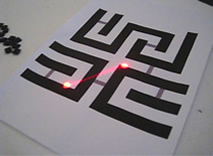 |
ConceptA laser spot bounces on a figure being drawn on paper, trying to escape the labyrinth of lines. There is no camera nor projector; this is an experience where the audience can touch and interact with a beam of pure light - and even play a pong game with bare hands. The quality of the laser light, and the fluidity of the motion makes for a very unique experience. |
 |
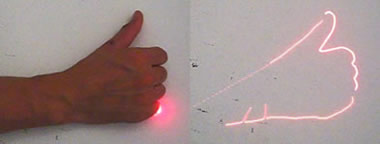 |
Technical StatementThe piece is based upon a 3d tracking technology developped in our lab in 2003, using a laser diode, a pair of steering mirrors, and a single non-imaging photodetector called the "smart laser scanner" (for details, see here). The hardware is very unique: since there is no camera nor projector (with pixellated sensors or light sources), tracking as well as motion can be extremely smooth and fluid. (The laser power is less than half a milliwatt - half the power of a not very powerful laser pointer - and does not supposes any hazard). Installation setupThe setup can be easily configured for interaction on an horizontal surface (see figures on the right), or a vertical surface. In the first case, the laser head can also be rotated to demonstrate drawing on clothes on people nearby. |
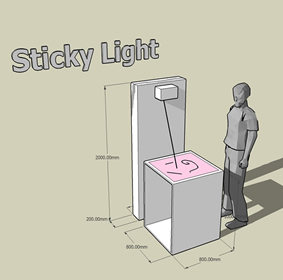 |
InteractionCurrently, we have prepared several applications. These are:
|
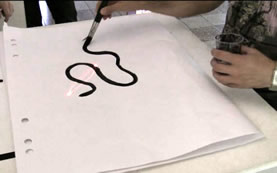 |
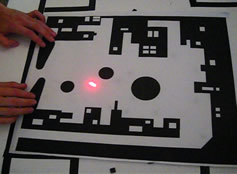 |
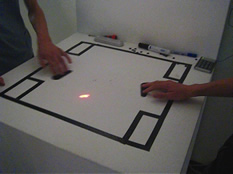 |
Artist StatementThe most interesting aspect of the installation is that it promotes a reflection on the role of light as a passive substance "used" for contemplating a painting or a drawing. Natural light, or an artificial spot of light is always necessary to illuminate what we want to see; the quality of the light, the position and angle will modify the perception of a painting. In fact, the source of light is not really passive: it interacts and modifies the perceived work in an essential way. |
The installation amplifies such effect: it gives the light spot new ways of interacting with the painting; it augments its content by scanning the drawing, following the lines and bouncing on the colors. By moving on the drawing, the light spot attracts the attention of the viewer. It actually forces our sight to follow the dynamic path taken by the light. The function of the scanner has been inverted: the laser scanner no longer "see" things, but build upon an exhisting graphic design in order to create new visual, dynamic structures. A clear example is the sticky light operating over a logo or a labyrinth. The eyes get the whole picture, but through the motion of the eyes we gain a deeper, sequential understanding of the shape. When several spots operate at the same time, we also start to apreciate symmetries and balances on the picture, through the oscillation of the line that interconnects the laser spots (see video). (In the case of the labyrinth, the light spots revolving around the center and the lines interconnecting them remind us of some sort of astronomical work, the laser drawing ever changing constellations) |
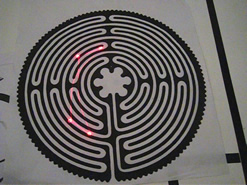 |
 |
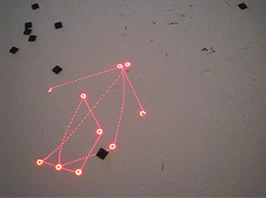 |
The scanned material does not need to be just a black and white flat drawing; it can be virtually anything (a colorful tissue, a moving volume). What it's needed is that the scanned object present enough contrast for the "sticky light" to be able to know it's whereabouts, and then stick and/or follow the countours and shapes (see video re-drawing hand). It can even change its direction or modulate the speed as a function of the colors or even the distace from the object to the laser head.
|
An interesting possibility going beyond the flat surface is to project on T-shirst or clothes (see video), or directly on the skin (see video). One could imagine a laser-augmented body painting performance, or a skin-painted dancer or wearing a dancer wearing a zebra-patterned outfit: the light spot would move on this surface, exploring its topography, and the dancer would move accordingly, trying to mantain the flow of light over the skin. She/he would move as if explored by the needle of a phonograph, or turned on a lathe. Here, again, the function of the scanner has been inverted: the scanner normally captures the form of a shape that rotates on a specifically designed rotating plate; in this new configuration, the act of "seeing" (by the scanner) generates the motion and modifies the shape of the observed object. |
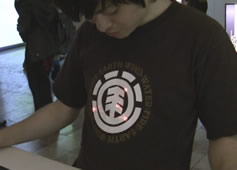 |
Credit details:
|
|
Contact
Alvaro Cassinelli. Assistant Professor (Research Associate). Department of Information Physics and Computing. The University of Tokyo. 7-3-1 Hongo, Bunkyo-ku, Tokyo 113-0033 Japan. |